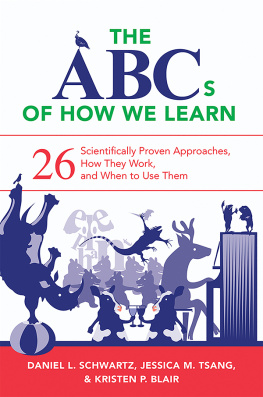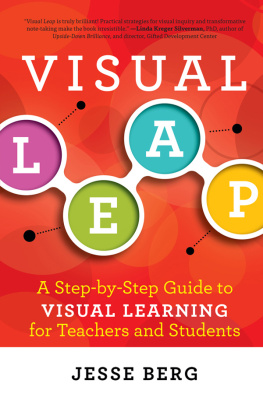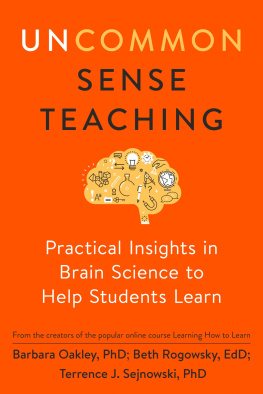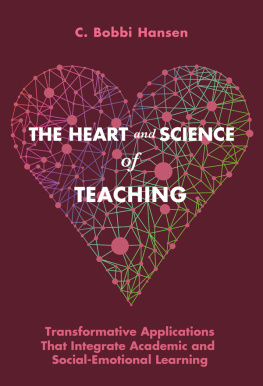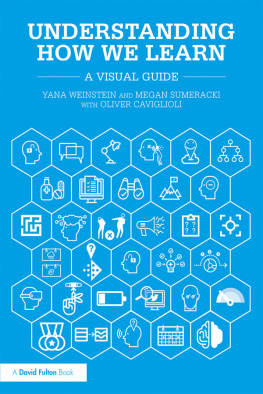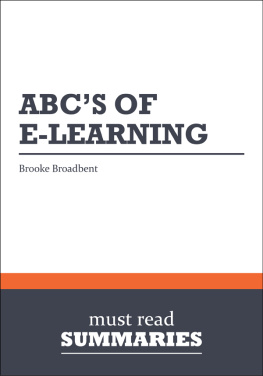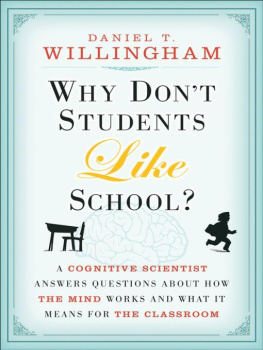
Norton Books in Education

DEDICATION
I am deeply grateful to the three Johns who served as my mentors: John Bransford, John Rieser, and John Black. Nobody makes it on their own. I am also indebted to the enthusiasm and encouragement of the Core Mechanics classes of 2012, 2014, 2015, and even the over-the-top class of 2013. DLS
To my professional mentors (a certain co-author included), and to my familymy mom and dad for supporting me, my husband, Scott, for sharing the adventure, and my daughters, Alissa and Madeline, for upping the ante on the chaos and the fun. KPB
This work is dedicated to the Oakland public schools, for giving me education, inspiration, and perspective. And to my littles, Oliver and Julius, who are also my biggest bigs. JMT
Contents 

H AVE YOU TAUGHT?
That is a rhetorical question. Of course you have.
Humans have a basic need to teach one another. Teachers do it; so do parents, friends, siblings, gossips, and employers. People even teach themselves. Today alone, among our many teaching experiences, we showed a toddler how to peel a banana, familiarized an out-of-town visitor with the commuter train, returned written feedback on a statistics assignment, and coaxed a puppy to sit, yet again.
Given that you have taught, you might also recall a time when it did not work very well. So, you tried another approach and it worked better. Here is a common example: Someone asks you for directions to a building or store, and you reply, Sure! because you certainly know where it is. But soon enough, you find yourself gesturing ineffectually as confusion crosses the listeners face. Finally, you just draw a map.
What is the moral of this story? It is not that perseverance pays off, though that is often true. The moral is that there are many different ways we teach one another. Moreover, different ways of teaching are suited to different types of learning. For instance, the visual system is very good at learning spatial material, and that is why a map usually works better than words when it comes to spatial directions.
Learning is not a single thingthere is no central processing unit responsible for all learning, and the brain is not a homogenous lump of neurons. The brain has many learning systems each of which has a different neural structure and a unique appetite. Effective instruction depends on choosing pedagogical moves that nourish the right learning system for the desired outcomes. If you want people to learn to respond appropriately to frustration, give them a chance to observe a role model, dont just tell them to buck up. If you want people to change their bad habits, use reinforcement, not willpower.
The purpose of this book is to help people understand learning and to creatively develop methods of instruction suited to their learning goals, whether for themselves or another.
At Stanford University, we teach an applied course that emphasizes learning theories that can be put into practice. The course draws beginning and advanced teachers, undergraduates, master students, doctoral students, lawyers, physicians, engineers, business men and women, and people who want to design learning technologies. The variety of students is evidence that people want to know about learning.
About five years ago, we abandoned the available textbooks. They never quite united theory, research, and practice in a way that was spot-on actionable for the variety of goals that teachersall of usbring to education. Instead, we organized the course by describing a number of important learning mechanisms, why they work, what they are good for, and how to use them.
The course is called the Core Mechanics of Learning. The expressioncore mechaniccomes from games, where there are specific interactions that drive a game forward. In golf, strike a ball into a hole. In Tetris, rotate falling pieces to land in place. Similarly, there are specific interactions that drive different types of learning forward. Good teaching is to arrange for those interactions.
A single course has limited time. We selected mechanisms that exemplify the most well developed learning theories, such as behaviorism (R is for Reward), social psychology (O is for Observation), perceptual psychology (C is for Contrasting Cases), cultural psychology (P is for Participation), and cognitive psychology (S is for Self-Explanation). (As cognitive psychologists, we think about thinking, and we learn about learning.) Once we switched to this format, students regularly requested a second course, so they could learn additional core mechanics. Human learning is fascinating!
Building on the demand, we decided to write the ABC book. We wrote it to be accessible and enjoyable for any person interested in learning and how to improve it. We also wanted it to be suitable as a textbook when elaborated with additional readings and appropriate tasks. For instance, a good task after reading a few chapters is to analyze a piece of instruction, such as an online math game, with the eye of a learning scientist. Students can analyze which learning mechanisms the experience enlists or misses, and how effectively they are brought to bear.
We chose 26 core mechanics that have strong evidence, comprehensible theories, and clear implications. We made some hard decisions about what to include. For example, we chose A is for Analogy, but we could have written A is for Attention. The book is not exhaustive. How could it be? The science of learning has exploded in the past 15 years, in part because of a $500 million investment by the National Science Foundation into centers dedicated to the science of learning. (We were members of the center, Learning in Informal and Formal Environments LIFE.) We chose the 26 chapters based on our own experiences as educators and researchers of learning, and our sense of what people want to know about. Someday, we might write a book called, The Other ABCs .
Each chapter is organized the same way. Our basic assumption is that knowing how something works, seeing the evidence for why it works, and providing multiple examples will help people generate their own insights and effective applications. The structure is as follows:
What it is. A basic statement of the learning mechanism and why it is important.
How it works. The science and theory, including accessible descriptions of seminal research.
How to use it. Examples of activities that recruit the learning mechanisms.
What it is good for. The outcomes that the learning mechanism is especially good for.
Its risks. Common mistakes that lead to undesirable consequences.
Examples of Good and Bad Use. Quick examples to help solidify the ideas.
References. A mix of classic and contemporary papers on the topic.
A Cheat Sheet. An elaborated outline that summarizes the main ideas of the chapter with brief examplesuseful as a reminder months or years after reading.
Educators often want people to achieve multiple learning outcomes for a single topic. For instance, one might want students to memorize scientific formulas, understand why they work, and develop an interest in becoming a scientist. Our hope is that the book gives a more differentiated picture of the many kinds of learning outcomes and the many strategies and techniques that can be combined to help learners achieve these multi-faceted outcomes. Good instruction can combine techniques from several chapters. For instance, for science, one might develop a lesson that enlists GAPGeneration, Analogy, and Participation, or maybe METMaking, Elaboration, and Teaching. The possible combinations are limitless.
Next page
